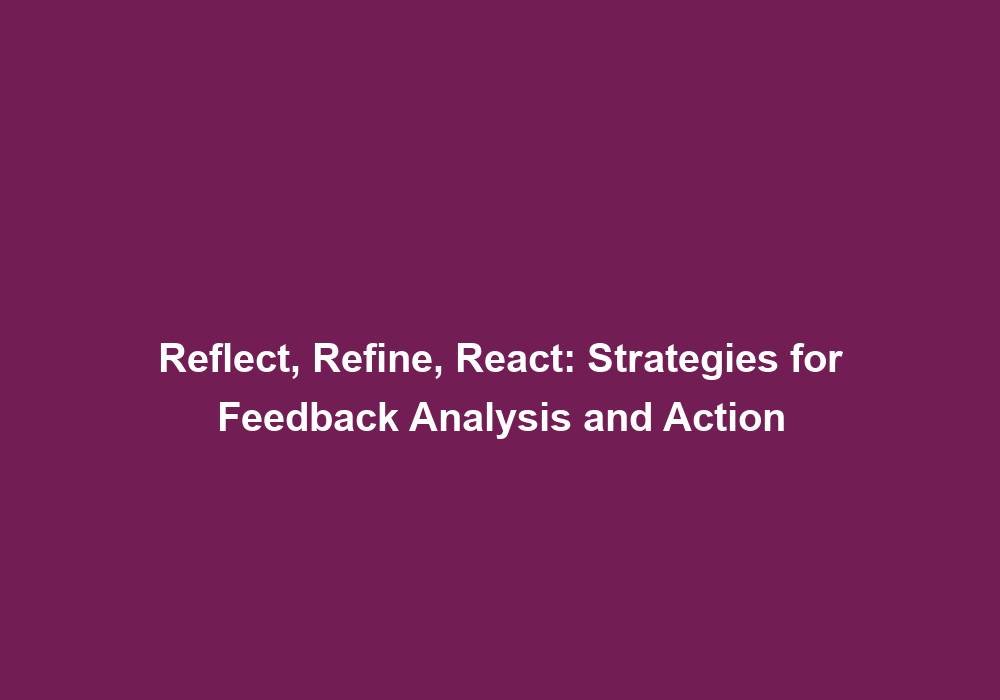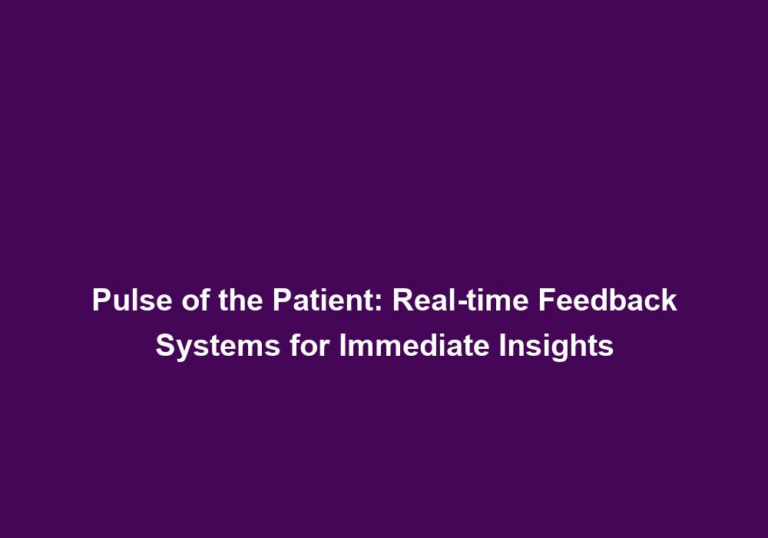Reflect, Refine, React: Strategies for Feedback Analysis and Action
Introduction
In today’s fast-paced digital world, feedback plays a crucial role in shaping the success of businesses and organizations. Whether it’s from customers, employees, or stakeholders, feedback provides valuable insights that can drive growth, improve products and services, and enhance overall performance.
To effectively harness the power of feedback, organizations need to adopt robust strategies for analysis and action. In this article, we will explore three key strategies – reflection, refinement, and reaction – that can help businesses make the most of feedback and drive meaningful change.
Reflect: Understanding the Importance of Reflection
Reflection is the first step in the feedback analysis process. It involves taking a deep dive into the feedback received and gaining a comprehensive understanding of its implications. By reflecting on feedback, businesses can identify patterns, trends, and areas of improvement.
1. Reviewing Feedback Data
To effectively reflect on feedback, it’s essential to organize and review the data systematically. This can be achieved by utilizing feedback management tools or software that collate and categorize feedback based on various parameters. By analyzing the data, organizations can identify common themes, recurring issues, and potential opportunities for improvement.
Furthermore, the analysis of feedback data can help organizations gain insights into customer preferences, pain points, and expectations. This understanding allows businesses to tailor their products, services, and customer experiences to meet and exceed customer expectations. By leveraging feedback data, organizations can develop customer-centric strategies that drive customer satisfaction and loyalty.
2. Identifying Key Stakeholders
In the reflection phase, it’s crucial to identify the key stakeholders who are responsible for acting on the feedback. This may include product managers, customer service representatives, marketing teams, or even top-level executives. By involving the right stakeholders, organizations can ensure that the necessary actions are taken to address the feedback effectively.
Moreover, engaging key stakeholders in the feedback analysis process fosters a sense of ownership and accountability. It empowers individuals to take ownership of the feedback and actively contribute to the development of solutions. By involving stakeholders at different levels of the organization, businesses can gather diverse perspectives and insights, leading to more comprehensive and effective actions.
3. Conducting Comparative Analysis
Comparative analysis involves benchmarking feedback against industry standards, competitor performance, or internal metrics. By comparing feedback with relevant data, businesses can gain valuable insights into their performance and identify areas where they excel or lag behind. This analysis can inform decision-making and guide further actions in the refinement and reaction phases.
Additionally, comparative analysis allows organizations to identify best practices and learn from industry leaders. By studying how competitors address similar feedback, businesses can gain inspiration for improvement and innovation. Comparative analysis also helps organizations set realistic goals and targets based on industry benchmarks, ensuring that their actions align with industry standards and expectations.
Refine: Transforming Feedback into Actionable Insights
Once feedback has been thoroughly reflected upon, the next step is to refine the insights and transform them into actionable strategies. This phase focuses on leveraging the feedback to drive meaningful change within the organization.
1. Prioritizing Feedback
During the refinement phase, it’s crucial to prioritize feedback based on its significance and potential impact on the business. By categorizing feedback into high-priority and low-priority issues, organizations can allocate resources and attention accordingly. This ensures that the most critical issues are addressed first, leading to quicker and more impactful improvements.
To prioritize feedback effectively, businesses can consider factors such as the frequency of the feedback, the severity of the issues raised, and the potential impact on customer satisfaction or business performance. By focusing on high-priority feedback, organizations can make targeted improvements that have a significant positive impact on their customers and overall business success.
2. Collaborating and Brainstorming
Refinement is a collaborative process that involves bringing together cross-functional teams to brainstorm solutions and strategies. By involving individuals from different departments and perspectives, organizations can leverage diverse expertise to develop comprehensive and innovative solutions. This collaborative approach fosters a sense of ownership and commitment towards addressing feedback.
During the collaborative brainstorming sessions, it is important to encourage open and honest communication. This allows team members to share their unique insights and experiences, leading to a more holistic understanding of the feedback and potential solutions. Collaboration also enables the identification of interdependencies and potential challenges, facilitating the development of well-rounded strategies.
3. Setting SMART Goals
To effectively act upon feedback, organizations need to define specific, measurable, attainable, relevant, and time-bound (SMART) goals. SMART goals provide a clear roadmap for implementation and allow progress to be measured accurately. By setting SMART goals, businesses can ensure that their actions align with the insights gained from feedback analysis and drive measurable results.
Setting SMART goals involves breaking down the broader strategies into smaller, actionable steps. Each step should have a clear objective, measurable metrics for success, and a defined timeline for completion. This approach enables organizations to track progress, identify potential bottlenecks, and make necessary adjustments to stay on course towards achieving the desired outcomes.
React: Implementing Actionable Steps for Change
The final stage in the feedback analysis process is reaction – taking actionable steps based on the refined insights. This phase focuses on implementing strategies, monitoring progress, and adapting to feedback in real-time.
1. Developing an Action Plan
An action plan outlines the specific steps, responsibilities, and timelines for implementing the refined strategies. It provides a structured framework for executing initiatives and ensures that everyone involved is clear about their roles and expectations. By developing a comprehensive action plan, organizations can streamline implementation and maximize the chances of success.
When developing an action plan, it is important to break down the strategies into smaller, manageable tasks. Each task should be assigned to a responsible individual or team, with clear deadlines for completion. Regular communication and progress updates are essential to ensure that the action plan stays on track and any issues or roadblocks are addressed promptly.
2. Monitoring Progress and KPIs
To ensure the effectiveness of their actions, businesses must closely monitor progress and key performance indicators (KPIs). This involves regularly measuring and tracking predefined metrics that align with the organization’s goals and objectives. Monitoring progress allows for timely adjustments, identifies potential bottlenecks, and enables the organization to stay on track towards achieving desired outcomes.
Monitoring progress and KPIs can be facilitated through the use of performance tracking tools and regular progress review meetings. By regularly reviewing and analyzing the data, organizations can identify trends, patterns, and areas for improvement. This data-driven approach enables businesses to make data-backed decisions, optimize their strategies, and make necessary adjustments to drive continuous improvement.
3. Encouraging Continuous Improvement
Feedback analysis is an ongoing process, and organizations must foster a culture of continuous improvement. By encouraging open communication, actively seeking and embracing feedback, and iterating on strategies, businesses can create an environment that values learning and growth. This continuous improvement mindset allows organizations to adapt quickly to changing market dynamics and consistently deliver exceptional products and services.
To encourage continuous improvement, organizations can establish feedback loops that enable regular communication and information sharing. This can be done through surveys, focus groups, suggestion boxes, or dedicated feedback channels. By actively seeking feedback from customers, employees, and stakeholders, organizations can identify areas for improvement and take proactive measures to address them. Embracing a culture of continuous improvement drives innovation, enhances customer satisfaction, and positions businesses for long-term success.
Conclusion
In conclusion, feedback analysis and action are vital for organizations seeking to thrive in today’s competitive landscape. By adopting a structured approach that involves reflection, refinement, and reaction, businesses can effectively leverage feedback to drive meaningful change. By understanding the importance of reflection, transforming feedback into actionable insights, and implementing concrete steps for change, organizations can unlock their full potential and achieve long-term success. So, embrace feedback, reflect upon it, refine your strategies, and react with purpose – your organization’s future depends on it.







